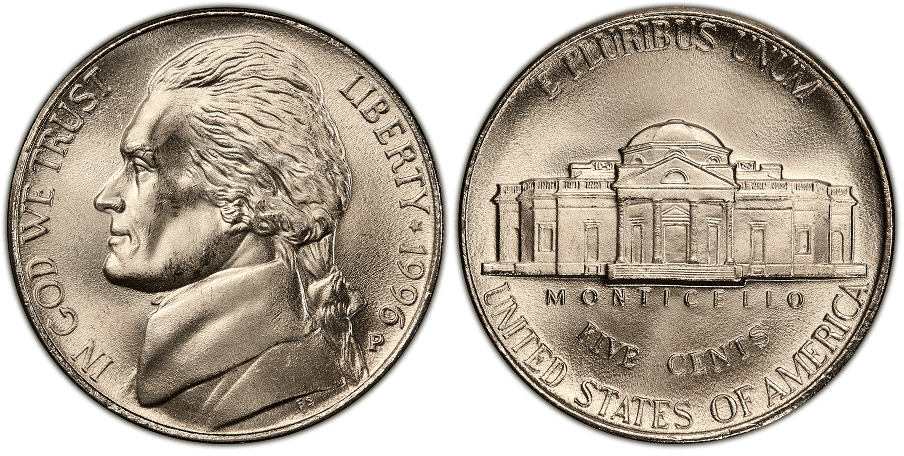The 1996 nickel is part of the Jefferson nickel series first struck in 1938. Since then, the US Mint has continually issued the Jefferson nickel up to this day. So, if you’re looking for a new coin to add to your collection, the 1996 nickel should be on top of your list.
Read through this post and learn about the history, value, composition, and design of the 1996 Jefferson Nickel.
What Is the 1996 Jefferson Nickel Made Of?
photo source: PCGS
The 1996 Jefferson nickel was struck in 1996 by the US Government. It was produced by three mints in Philadelphia, Denver, and San Francisco.
The Jefferson nickel has always been made with 75% copper and 25% nickel, except for those issued from mid-1942 to 1945. Today, the 5-cent coins minted during those years are called the “Wartime Nickels” and were made with 9% manganese, 35% silver, and 56% copper.
You might wonder why the US Mint changed its composition during these years. The years from 1942 to 1945 were when the United States was at war with the Axis Powers. It was a huge and expensive war to join.
Nickel was considered an important raw material for making bullets, guns, and war equipment. Thus, Congress asked the US Mint to conserve nickel. This led the US Mint to remove nickel from the 5-cent coin.
When it comes to design, the obverse of the 1996 Jefferson features the image of Thomas Jefferson, the third US president and one of the nation’s founding fathers.
Aside from Jefferson’s picture, the 1996 nickel’s obverse includes the following inscriptions:
- IN GOD WE TRUST
- LIBERTY
- 1996
- Mint mark (if present)
- FS (Felix Shlag initials)
On the reverse, you’ll find the front view of Jefferson’s Monticello mansion. Inscriptions include the following:
- E PLURIBUS UNUM
- MONTICELLO
- FIVE CENTS
- UNITED STATES OF AMERICA
The Jefferson nickel replaced the Buffalo nickel, which the US Mint has issued for 25 years. The US Mint loved the design, but the Buffalo nickel was difficult to mint. The die broke easily, and the finished coin product easily disintegrated.
By January 1938, the US Mint held a design competition, and Felix Schlag’s design won. From there, the Jefferson Nickel was born.
1996 Jefferson Nickel Varieties
The 1996 Jefferson nickel has three varieties from the Denver, Philadelphia, and San Francisco Mints. The Denver and Philadelphia Mints worked together to produce regular nickels, while the San Francisco Mint produced the proof nickel coins.
Here’s what the mintage looks like:
| Variety | Mint Location | Mintage |
| 1996 P Jefferson Nickel | Philadelphia | 829,332,000 |
| 1996 D Jefferson Nickel | Denver | 817,736,000 |
| 1996 S Proof Jefferson Nickel | San Francisco | 2,525,265 |
| Total | 1,649,593,265 |
As you can see, more than 1.6 billion nickels were produced in 1996. 1996 was the third time in a row that the US Mint exceeded the 1 billion mark. However, in 1997, the mintage figure dropped below 1 billion.
Now, let’s take a deeper look at each of the varieties:
1996 P Jefferson Nickel
Edge: Plain
Mint Mark: none
Place of minting: Philadelphia
Year of minting: 1996
Face Value: $0.05 (five cents)
Price: $0.10 to $0.20 (circulated condition)
Quantity produced: 829,332,000
Designer: Felix Schlag
Composition: 75% Copper, 25% Nickel
Mass: 5.00 grams
Diameter: 21.20 mm
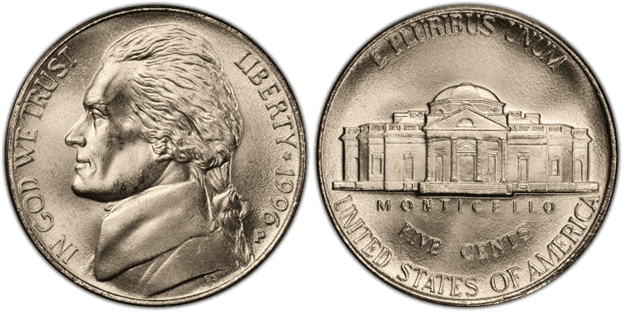
The Philadelphia Mint produced more than 829 million nickels in 1996, far exceeding the Denver Mint’s mintage figure. The Philadelphia Mint also produced more nickels in 1996 than 1995 and 1997.
1996 D Jefferson Nickel
Edge: Plain
Mint Mark: none
Place of minting: Philadelphia
Year of minting: 1996
Face Value: $0.05 (five cents)
Price: $0.10 to $0.20 (circulated condition)
Quantity produced: 817,736,000
Designer: Felix Schlag
Composition: 75% Copper, 25% Nickel
Mass: 5.00 grams
Diameter: 21.20 mm
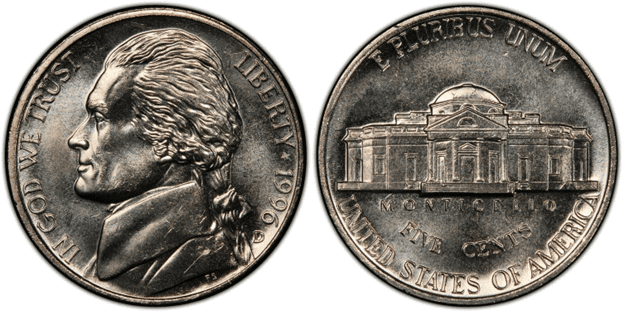
The Denver Mint produced more than 817 million nickels. With a high mintage figure like this, you should find 1996-D nickel with fair ease.
1996 S Proof Jefferson Nickel
Edge: Plain
Mint Mark: S
Place of minting: San Francisco
Year of minting: 1996
Face Value: $0.05 (five cents)
Price: $10 or more (circulated condition)
Quantity produced: 2,525,265
Designer: Felix Schlag
Composition: 75% Copper, 25% Nickel
Mass: 5.00 grams
Diameter: 21.20 mm
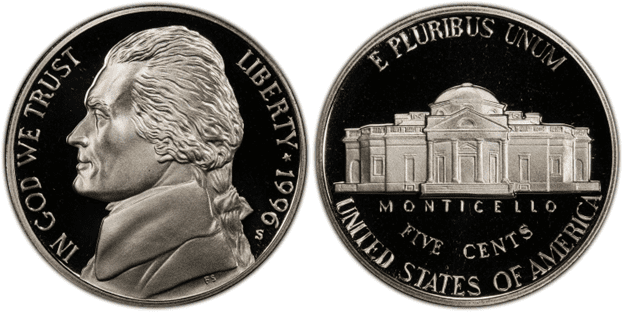
The San Francisco Mint used technologically advanced equipment to produce well-struck 1996 proof nickels. So, you should easily find 1996-S proof coins in top grades up to PR 69 Deep Cameo. However, PR 70-graded nickels could be a little difficult to find, but still not impossible to do so.
List Of 1996 Jefferson Nickel Errors
The 1996 Jefferson nickel isn’t exempted from coin errors. Due to high mintage, there’s a bigger chance that error coins would happen. Check out this list of nickels with errors and see which one of them interests you:
Off-center strike error
The off-center strike happens when there’s a misalignment between the die and planchet. The degree of off-centeredness depends on the level of misalignment. Here’s what an off-center strike error looks like in 1996 nickel:
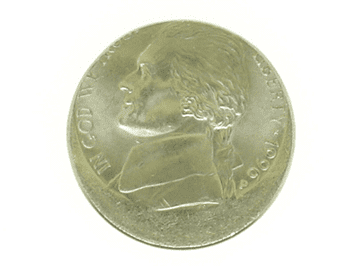
Die chip error
Because of wear and tear, some portions of the die might fall or chip away. When this happens, a part of the coin’s surface would look like a small blob.
Here’s an example of a die chip error on a 1996 nickel:
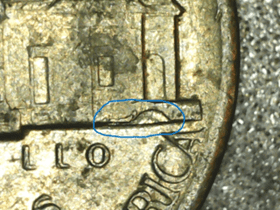
Broadstrike error
A die collar holds the planchet to keep it in its place, especially at the moment of the die strike. However, the die collar might loosely hold the planchet. So, when the die hits the planchet, it spreads like a pancake.
Here’s what the broadstrike error looks like on a 1996 nickel:
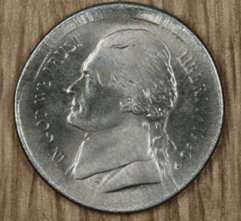
How Much Is 1996 Jefferson Nickel Worth Today?
The 1996 Jefferson nickel isn’t that valuable when you consider its face value, which is 5 cents. Even its melt value isn’t that much, reaching up to $0.0640. Circulated 1996 nickels are also just less than 0.30 cents.
Let this not discourage you from collecting 1996 nickels because some 1996 nickels are more valuable than their face value or melt value.
Take a look at this comparison table of auction records and see how much some 1996 nickels were sold in the past:
| Coin | Condition | Grade | Sold date | Sold by | Value |
| 1996 D Jefferson Nickel | Gem Uncirculated | MS 65 – Full Steps | December 13, 2004 | Heritage Auctions | $805 |
| 1996 P Jefferson Nickel | Superb Gem Uncirculated | MS 67 – Full Steps | June 26, 2008 | Heritage Auctions | $690 |
| 1996 S Proof Jefferson Nickel | Perfect Uncirculated | PR 70 – Deep Cameo | April 24, 2013 | Heritage Auctions | $306 |
How Does The Grading System Work?
The 1996 nickel is graded based on various factors such as quality of strike, attractiveness, and color.
Professional numismatists joined in the 1970s and established CoinGrading standards, known as the Sheldon Scale. These numismatists now assign grades at key places on the seventy-point scale, using the most regularly utilized numeric points in conjunction with the original adjective grade. The following are the most common coin grades:
- (P-1) Poor – Indistinguishable and probably damaged; if used, must have a date and mintmark; otherwise, rather battered.
- (FR-2) Fair – Nearly smooth, but without the damage that a coin graded Poor often possesses. The coin must have enough detail to be identified.
- (G-4) Fair – Inscriptions have merged into the rims in some areas, and important elements have been mostly erased.
- (VG-8) Very Good- A little weathered, but all primary design elements are visible, albeit faintly. There is little, if any, central detail left.
- (F-12) Good – The item is very worn, yet the wear is even, and the overall design details stand out clearly. Rims are almost completely isolated from the field.
- (VF-20) Very Fine – Moderately weathered, with some finer features still visible. The motto or all letters of LIBERTY are readable. Both sides of the coin have entire rims separated from the field.
- (EF-40) Extremely Fine – Gently used; all gadgets are visible, and the most important ones are bold. The finer details are bold and clear; however, light wear may be seen.
- (AU-50) Uncirculated – Slight evidence of wear on the coin’s design’s high points; it may have contact marks; eye appeal should be adequate.
- (AU-58) Uncirculated Choice – Slight traces of wear, no severe contact marks, almost full mint shine, and great eye appeal.
- (MS-60) Mint State Basal – Strictly uncirculated; no indication of wear on the coin’s highest points, but an unsightly coin with reduced luster, visible contact marks, hairlines, and other flaws.
- (MS-63) Mint State Acceptable – Uncirculated, but with contact scratches and nicks, little reduced shine, but otherwise appealing appearance. The strike is weak to average.
- (MS-65) Mint State Choice – Uncirculated with great mint shine, little contact blemishes, and exceptional eye appeal. The strike is unusually severe.
- (MS-68) Mint State Premium Quality – Uncirculated with superb luster, no obvious contact marks to the naked eye, and exceptional eye appeal. The strike is quick and appealing.
- (MS-69) Almost Perfect Mint State – Uncirculated with perfect brilliance, a sharp and appealing strike, and extremely good eye appeal. A near-perfect coin with minor imperfections in the planchet, strike, and contact markings (seen only under 8x magnification).
- (MS-70) Mint State Perfect – Under 8x magnification, no tiny imperfections are discernible; the strike is crisp, and the coin is perfectly centered on a beautiful planchet. Rarely seen on a coin, this coin is bright and whole, with original luster and exceptional eye appeal.
Where To Buy Or Sell 1996 Jefferson Nickel?
Buying and selling a 1996 Jefferson nickel is fun and daunting at the same time. Fun because you’re going to explore different places and get a lot of pleasant surprises along the way. Daunting because, with the many (or lack of) options, you might have difficulty finding the right Jefferson nickels for you.
To give you a headstart, check out these places where you might be able to buy or sell 1996 Jefferson nickels:
- Coin dealers – you can visit coin dealers in coin shops, antique stores, and even pawn shops.
- Auction houses – some of the rarest and most expensive coins were sold in an auction.
- Social media platforms – you can go to Facebook, Twitter, Instagram, and other related platforms to look for people who might be interested in buying or selling your coins.
- Online marketplaces – you can go to eBay, Amazon, and Etsy. These places will both help you in selling and buying coins.
- Specialized websites – a quick Google search will give you a list of websites specializing in selling and buying coins. Give it a try. These websites include USA Coin Book, Coin Appraiser, and JM Bullion.
FAQs
How much should a 1996 nickel weigh?
The 1996 nickel weighs 5 grams.
How do I know if a 1996 nickel is worth anything?
Suppose you believe your 1996 nickel is something unique and it possesses something that would make it different from other coins. You can bring your 1996 nickel to professional coin grading service providers in that case. These include the PCGS, NGC, and ANACS. They can look into your coin and confirm whether your 1996 nickel is of great value.

